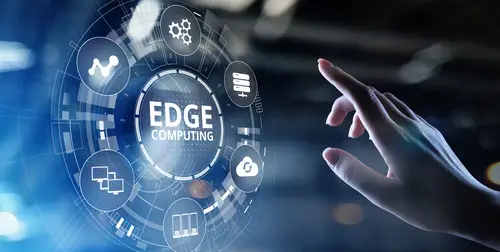As the digital world continues to evolve, it is becoming increasingly clear that edge computing is not just a fleeting trend but an integral part of our technological future. In this post titled “Edge Computing: Bringing Processing Power Closer to the Source,” we will delve into the fascinating realm of edge computing. A revolution that promises faster processing times, reduced latency and enhanced data privacy. Imagine having lightning-fast internet speeds or autonomous cars with real-time decision-making ability all made possible by shifting computational power from centralized servers closer to where data originates. This shift in technology not only disrupts traditional cloud models but also holds enormous potential for countless industries seeking efficient ways to manage Big Data. Join us as we unravel how ‘Edge Computing’ could be your next competitive advantage in this fast-paced, digitally-driven landscape!
Understanding the Basics of Edge Computing
Edge computing is a revolutionary approach that brings processing power closer to the source of data and enables real-time analysis and decision-making. By moving data processing closer to where it is generated, edge computing reduces latency, bandwidth usage, and reliance on centralized data centres. This technology distributes data processing resources to the edge of the network. It allows for faster processing of data without the need to transfer it back and forth to a distant server. Edge computing is especially important in IoT devices, autonomous vehicles, and critical infrastructure that require instantaneous processing for efficient operations. Understanding the basics of edge computing involves grasping the concept of decentralized data processing and its role in enhancing speed, efficiency, and reliability in various applications.
Components and Architecture of Edge Computing
Edge computing refers to the decentralized processing of data closer to its source, rather than relying on a central data center. This approach reduces latency, enhances efficiency, and improves overall performance for real-time applications. The key components include edge devices, such as sensors and cameras. They help collect data at the source, edge servers that process and analyze this data nearby, and edge gateways. Serving as a bridge between the edge devices and the cloud. This architecture enables faster decision-making, lower bandwidth usage, and increased security by keeping sensitive data localized. By distributing computational power at the edge of the network, organizations can optimize their operations and deliver more responsive services to end-users.
Benefits of Bringing Processing Power Closer to Source
Bringing processing power closer to the source through edge computing offers numerous benefits across various industries. One key advantage is reduced latency, as data processing occurs closer to the devices generating the data. This results in faster response times, critical for time-sensitive applications such as autonomous vehicles and real-time monitoring systems. Furthermore, it enhances data security by minimizing the need to transmit sensitive information over long distances to centralized servers. This reduces the risk of data breaches and ensures better compliance with privacy regulations.
Another benefit is improved reliability and resilience. By distributing computing resources closer to where data is generated, organizations can mitigate the impact of network failures or outages. This decentralization also provides scalability, allowing for flexible resource allocation based on demand. In addition, edge computing enables more efficient use of bandwidth by processing data locally before transmitting only relevant information to the cloud. This helps alleviate network congestion and reduces operational costs associated with data transfer. Moreover, this computing branch facilitates real-time analytics and insights, enabling organizations to derive value from their data more quickly. This has significant implications for enhancing decision-making processes and optimizing operations in sectors like manufacturing, healthcare, and retail. Overall, bringing processing power closer to the source through edge computing empowers businesses to harness the full potential of their data, drive innovation, and deliver superior customer experiences in today’s fast-paced digital world.
Real-world Applications and Use Cases for Edge Computing
Edge computing is revolutionizing the way data is processed and managed in various industries. This leads to a wide array of real-world applications and use cases. In the healthcare sector, edge computing is enhancing patient care by enabling real-time monitoring and analysis of vital signs. This allows for immediate response in critical situations. In the transportation industry, it is being used to improve traffic management systems. It reduces congestion and optimizing route planning for vehicles.
Additionally, in the retail sector, edge computing is revolutionizing the customer experience by enabling personalized recommendations and targeted advertising based on real-time data analysis. Moreover, in the manufacturing sector, it enhances operational efficiency by enabling predictive maintenance of equipment through real-time monitoring of performance metrics. In the agriculture industry, it helps optimize crop management by collecting and analyzing data from sensors in the field. It helps make informed decisions about irrigation and fertilization. Furthermore, in the energy sector, this computing branch is improving the management of power grids by enabling real-time monitoring and control of energy distribution. Overall, edge computing is transforming industries by bringing processing power closer to the source of data generation. This enables faster decision-making, improved efficiency, and enhanced user experiences.
Future Trends
In the rapidly evolving landscape of technology, the future trends in edge computing technology are poised to revolutionize the way data is processed and transmitted. One of the key areas of focus is the advancement of edge devices. This helps them become more powerful and capable of handling complex computations closer to the source of data generation. It will not only reduce latency and improve efficiency but also enable real-time decision-making. Preferably in critical applications such as autonomous vehicles and smart cities. Another trend is the integration of artificial intelligence and machine learning algorithms at the edge. It allows for faster and more intelligent processing of data without relying solely on centralized cloud infrastructure. As edge computing continues to mature, we can expect to see an increasingly decentralized and distributed network of devices working together seamlessly to power the next generation of technology solutions.

 Exploring the Latest Social Media Trends and How to Use Them
Exploring the Latest Social Media Trends and How to Use Them 10 Hidden iPhone Features You Didn’t Know Existed
10 Hidden iPhone Features You Didn’t Know Existed